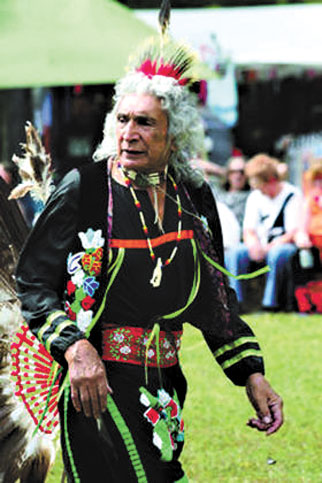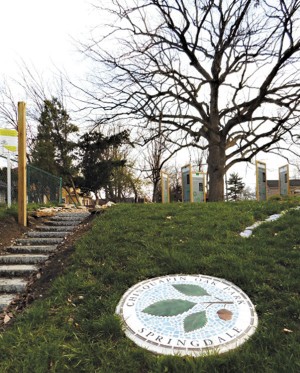INDIANAPOLIS — The Springdale Neighborhood on the Near Eastside of Indianapolis is honored to have not one, but two ancient chinquapin oak trees a short distance from each other, both estimated to be over 300 years old. Through a partnership with Keep Indianapolis Beautiful, Inc. (KIB), Springdale created a permanent greenspace and walk to share with nature lovers everywhere. The public is invited to participate in an opening celebration for the newly formed Chinquapin Oak Park on Saturday, May 20 from 1 p.m. to 3:30 p.m. at 2319 Nowland Avenue.
Starting with a guided tour of the Chinquapin Oak Walk, co-led by Springdale neighbor, naturalist and Senior Project Manager of Eagle Creek Park, Brittany Davis Swinford, and Callie McCune of the Indiana Historical Society, the tour will follow tile markers in the sidewalk along Brookside Parkway South Drive to the Temple oak, then into Spades Park to view the bird sanctuary and finally back to Chinquapin Oak Park for the opening celebration starting at 2 p.m. Springdale neighbor Jerry Shepherd initiated the bird sanctuary five years ago. With its confluence of prairie, creek, and woods, it provides ideal habitat for a variety of species.
The celebration will include a retelling of the story of how the Nowland oak got saved in 2012. In honor of the Native Americans who were in the area when the tree began growing around 1716, one hundred years before Indiana became a state, there will be a blessing from Elder LeRoy Malaterre. Originally from the Turtle Mountain Chippewa Reservation in North Dakota, Malaterre is well known and respected in Indiana as one of the early proponents of preserving the Native American culture in the state. His nephew Matt Orcutt will be on drum. The public will be invited to participate in a round dance. Doug Poe, director of the American Indian Center of Indiana located in the John H. Boner Community Center, will talk about the customs and history of the Native Americans who lived in the area during the tree’s early years.
Burgers and hot dogs will be available, and participants are invited to bring pitch-in items, especially pioneer-themed and Native American dishes.
The story of the saving of the tree began in August of 2012 when then-president of Springdale Neighborhood Association Chris Hartley noticed a “really fantastic huge tree” while strolling through the alley behind the 2300 block of Nowland Ave. Chris learned the house in front of the tree was scheduled shortly for demolition by the city. So he contacted KIB to see if the organization could help protect the tree during the demolition process. Thanks to Chris’ sleuthing, and quick action by KIB’s Andrew Hart, they were able to work with the city to ensure the tree wasn’t harmed. Fast forward to the spring of 2015, when Springdale applied for an IPL Project GreenSpace grant from KIB so that the tree, now on an empty lot, could be preserved long-term. Springdale was awarded the grant, and after a year of collaborative effort between Springdale volunteers, KIB, and a laundry list of partners, the park was completed last fall.
The focal point is a group of 8-foot tall panels with the history of the area during the time the tree has been growing on one side of the panels, and information about trees and the environment on the other. The panels are installed on a round flagstone patio with variegated colors that mimic the rings of a tree. Surrounding the patio are native plantings of grasses, bluebells and yellow wood poppies, and a timber boardwalk. Granite steps lead up to the park from Nowland Avenue, thanks to a generous donation from Santarossa Mosaic & Tile Co. However for those who would prefer not to climb a hill, one can enter on level ground from the alley behind the park. Midway up the hill, a 3-foot mosaic version of the tile marker designed by ceramic artist Barb Zech greets visitors, and at the crest of the hill is a surface-level sculpture by Springdale artist Nick Gehlhausen, made of broken pieces of concrete and bits of colored tile that mimic the roots of the oak.
Located a few houses south of Spades Park where Pogue’s Run Trail will eventually go through, Chinquapin Oak Park will be an easy detour for anyone on the trail, or walking through the eastern section of Spades Park.




